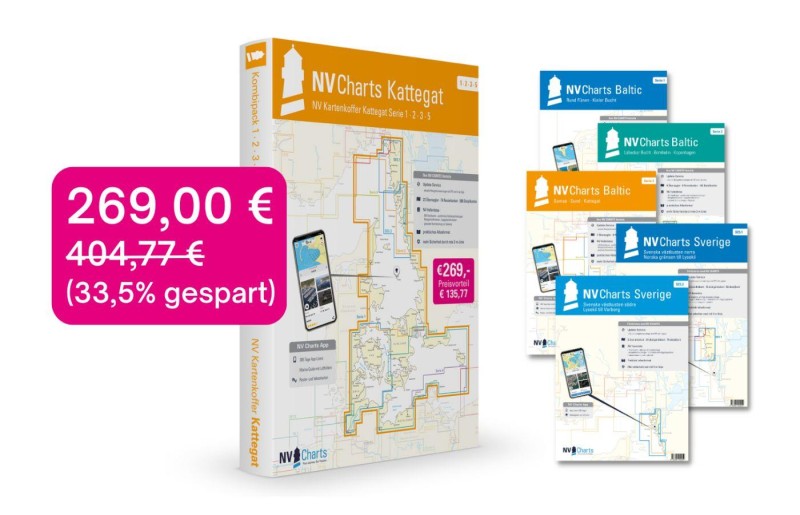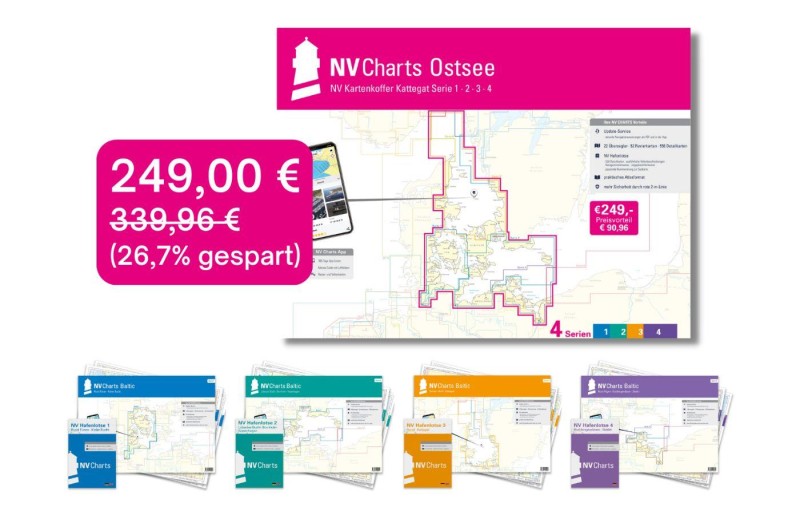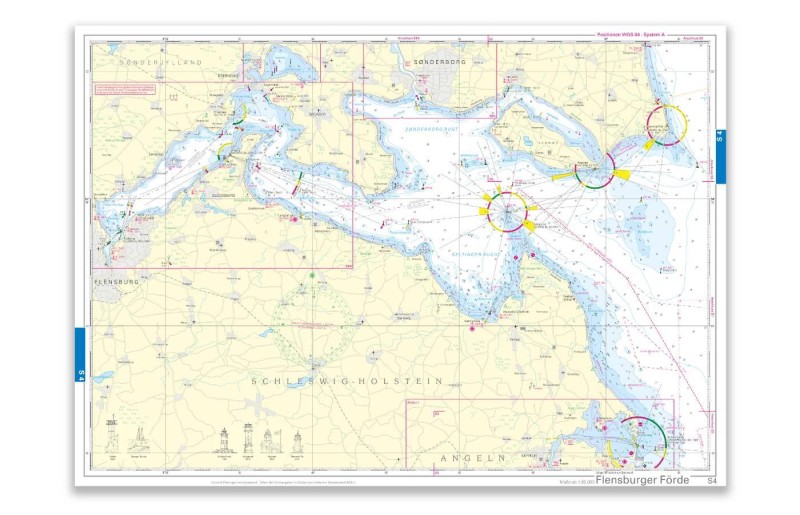Flensburg - Marina Werftkontor
Marina near Flensburg (Blasberg)
Latitude
54° 47’ 39.8” NLongitude
9° 26’ 11.8” EDescription
The Werftkontor marina is located on the east bank of the Flensburg Fjord. It is about a 10-minute walk to the city center. The jetty consists of concrete pontoons with rubbing strips and the other harbor facilities are also in good condition.
NV Cruising Guide
Navigation
The approach is unproblematic day and night. Approaching the inner harbor from buoy 13 or Tn 14, first head for the Kielseng light tower at the sewage treatment plant (white sector at night). After passing Tn 15, head for the leading light line 229°. Take care on the east side, where deviation dolphins stand freely in the water. Continue steering through the approx. 250 m wide entrance into the spacious harbor basin of the inner harbor by sight.
Berths
Mooring opposite the old town with good sanitary facilities and restaurants. Walking distance to the city center is 20 min. Attention: Do not use the landside pier; 3 large stones at 0.8m. Individual berths for yachts from 9 - 25 m in length.
Surroundings
All supply and repair facilities are in Flensburg. The sailmaker Oleu-Segel can be found in Galwig, while Flensburger Yachtservice offers a complete service including a nautical store in the Industiehafen.
NV Land Guide
Shipping and trade made Flensburg famous in the early Middle Ages. The conditions for this were still very modest around 1200: A mooring bridge and a small marketplace laid out by merchants from the Danish St. Knudsgilde formed the beginning. In 1284, the Danish Duke Waldemar IV confirmed Flensburg's town charter. Just four centuries later, Flensburg was the richest and - according to contemporary accounts - also the noblest town in the Duchy of Schleswig. Its favorable geographical location facilitated diverse trade relations with the Scandinavian countries and the German Hanseatic cities. Flensburg became the gateway to the north in economic and cultural terms.
A model of the city on the first floor of the Flensburg Maritime Museum at Schiffbrücke 39 shows what the trading metropolis of Schleswig looked like in its heyday around 1600. In those days, the town on the fjord of the same name had 200 (!) ships and 6000 inhabitants.
A visit to the shipping museum, a former customs packing house, is not to be missed. It provides extensive information about trade and shipbuilding in the heyday of sailing and the development of the port city. Whaling, the West Indies voyage and rum production are just some of the topics covered in the exhibition. Flensburg rum was not only popular among sailors. At the beginning of the 19th century, the by-product of raw sugar from the Danish colonies became an important economic factor in the fjord town. Around half a million liters are said to have come to Flensburg in the first ten years of the last century alone. Other exhibits include ship models, old photographs and nautical charts from the early days of sailing. At first glance, it is difficult to recognize that the map by Lucas Jancz Waghenaer is a nautical chart of the Baltic Sea from 1585. This is not surprising, as there was a lack of knowledge at the time to accurately measure the coastlines. Nevertheless, the map on display in the museum shows some shallows and the rough coastal profiles in the southern Kattegat and the Belts. A nautical chart of the Sound and the Belts from 1700 shows that a hundred years later, much more knowledge was already available.
A model ship in the museum is, of course, the lightship Kalkgrund, which was later renamed "Flensburg". Flensburger Schiffbaugesellschaft delivered the ship to the Flensburg Royal Hydraulic Engineering Inspectorate in 1910, which stationed it on the outer fjord. It was not replaced by a lighthouse until 1963. A ship's carpenter's chest from the 19th century, a ship's pharmacy from the 18th century, a chronometer from around 1840 and much more make a visit to the shipping museum, which opened in 1984, worthwhile.
A few steps away from the shipping museum, Flensburg's museum harbor with its gaff-rigged schooners and cutters provides the perfect backdrop to the museum. In the fall at apple harvest time, the old sailors set sail as they used to and "supply" the people of Flensburg with apples, which they take on board in Glücksburg. Nowadays, the traditional apple cruise is mainly a popular spectacle around the museum harbor. The historic sailing ships meet every year in May for the Rum Regatta. Thanks to the preservation of old buildings, the environment along the ship bridge also fits in with the museum harbor. Ship chandlers and taverns in narrow alleyways nearby create the right atmosphere. These picturesque alleyways also include the infamous Oluf Samsons Gang.
In general, Flensburg is one of the most attractive cities in Schleswig-Holstein, which is also due to the fact that the city survived the Second World War almost unscathed. Successful renovations in recent times also contribute to a pleasing cityscape. Examples of this are the Künstlerhof at Norderstraße 20 to 22 and the Kaufmannshof at Norderstraße 86. The half-timbered courtyard wings of the Künstlerhof are among the oldest in Flensburg. The complex dates back to the middle of the 16th century.
The Nordertor, built in 1595, is Flensburg's landmark. It formed the northern boundary of the city until 1795. Above the archway are the Danish royal coat of arms of Christian VII and the town's coat of arms. On it is a wise insight from the crises and wars of the Middle Ages: "Peace nourishes, discord consumes". It is clear to see that the town experienced a further upswing at the hands of the Prussians after its initial heyday around 1600. Large parts of the city are characterized by the buildings of the Wilhelminian era.
On the tour through Flensburg, the Rummelgang, the Toosbüystraße, the Holm and the Marienstraße should be visited. Marienstraße was the former Norderkuhgang, where the citizens' cattle were driven daily to the city fields outside the Marientor. House number 19/21 in the Holm is particularly noteworthy. This is the oldest surviving trading yard from Flensburg's heyday before the Thirty Years' War. From Große Straße 24, you come to a powerful testimony to the time of Flensburg's trade links to the West Indies, the large West India warehouse. The Schrangen, a building with an arcade where bakers and butchers once had their stalls, leads to the Nordermarkt. On the gable end of the Schrangen you can still see the bracket for the neck iron to which anyone who spoke ill of their fellow citizens was chained. Nordermarkt and Südermarkt are among the oldest planned centers of the city, built around 1200. The Neptune Fountain dates back to 1758 and a visit to Rote Straße above Südermarkt is highly recommended. It is characterized by craftsmen's yards from the 18th and 19th centuries. Also worth seeing is Kompagniestraße, which is lined with half-timbered houses and ends with the Kompagnietor gate. It was built in 1602 by the Flensburger Schiffergelag, the professional association of Flensburg skippers and merchants. The gable bears the city coat of arms from 1603 and the motto "Gerecht und Metich alltidt sin mit Godes Hülp bringt grodt Gewinn" (To be just and moderate at all times brings great profit with God's help). The high water marks from storm surges can be found on the gate building.
The municipal museum at Lutherplatz 1 displays a rich collection on the art and cultural history of Schleswig. The silver treasure from the Nydam Moor (450 AD) is also on display. Also of interest is a sequence of historical farmhouse parlors in Schleswig-Holstein from the 17th and 18th centuries. A separate exhibition room is dedicated to the painter Emil Nolde. The natural science museum at Süderhofenden 40/42 is dedicated to the flora and fauna of Schleswig-Holstein and also houses the city library with a reading room.
A Renaissance organ façade can be seen in St. Nikolai Church in the south of the pedestrian zone, which is considered to be the best in the entire north.
Flensburg is a popular shopping city, especially among Danes. The pedestrian zone is successfully integrated into the cityscape.
If you take a trip across the Padborg border to Denmark, you are not far from the Fröslevlejrens Museum on the north-western outskirts of Padborg. The museum is a former World War II internment camp. The main watchtower and one of the prisoner barracks commemorate imprisonment and the Second World War.
Ferries run from Flensburg to Kollund, Glücksburg and Gravenstein, among other places.
Marina Information
Contact
| Phone | +49 172 5188066 |
| Please enable Javascript to read | |
| Website | http://www.marina-werftkontor.de |
Surroundings
Electricity
Water
Toilet
Shower
Restaurant
Grocery
Public Transport
Garbage
Comments
You can add comments with the NV Charts App (Windows - iOS - Android - Mac OSX).
You can download the current version at nvcharts.com/app.
Buy nv charts covering this place Clicking one of the products will open the nv charts shop.
Places nearby
Related Regions
This location is included in the following regions of the BoatView harbour guide:











No comments or ratings have been added to this POI.